
about ddr |
forums |
buy ddr |
radio |
song lists |
FAQs |
machine locations |
radio |
song lists |
FAQs |
machine locations |
 |
|
| Guitar Mania Freedom V Wireless Guitar Controller by Cutriss, 31 October 06 Does Guitar Hero share that similarity? Not really. Of course, the controller is important and will make or break your experience with the game...but the official Guitar Hero controller, which pretty much every owner of the game should have, is enough to take you to the "endgame", shall we say. What room does that leave for manufacturers of third party accessories, such as The Ant Commandos? An excellent question. Let's explore that while we take a look at one of TAC's forefront products, the Freedom V Wireless controller. 
Here, you can see the ginormous box it comes in, complete with the TAC tape. 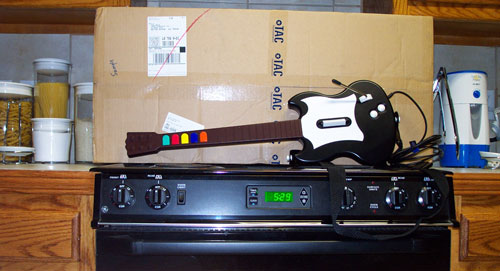
Of course, when you put it up against the official SG controller, it doesn't look *that* large. 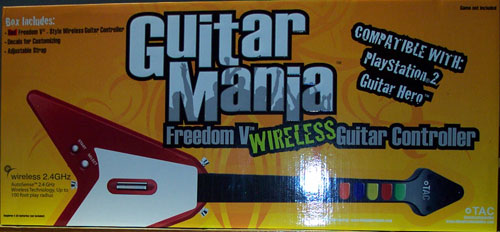
Here's the retail packaging, if you ever see it in stores. Very nicely done, contrary to the "packaging" most arcade-style DDR pads get. 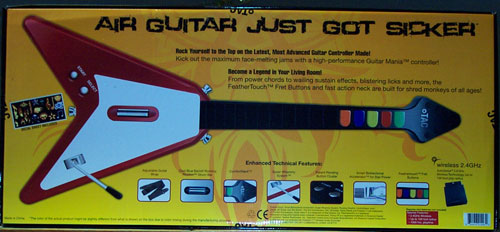
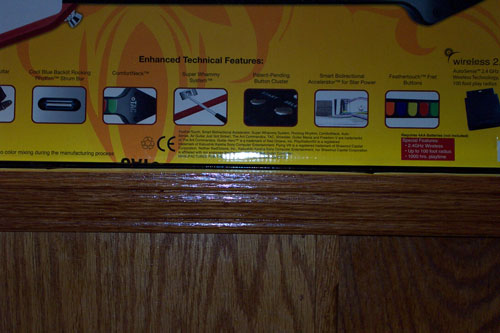
Here's the back of the box. It's not particularly notable, but I wanted to include the image for the armchair lawyers out there that want to nitpick about he presence or absence of trademark information and product reference...that sort of thing. It's worth noting that, as of the press time of this review, RedOctane and The Ant Commandos have requested a delay in court proceedings to try to work out the lawsuit between them. We won't comment any further on the lawsuit in this review. 
Here's what's in the box. You get the Freedom V Wireless, the obligatory guitar strap, the wireless receiver, and some decorative stickers. The first thing I noticed between the guitars was the size difference. The Freedom V Wireless (modeled after the classic Gibson "Flying V") is a bit longer, both in body and in neck. This means the fret buttons are pushed out a little bit more, a design change I was happy to see. The button placement for Start/Select is also visibly different. 
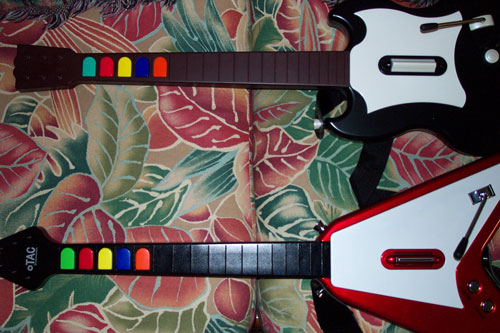
Here you can see the guitars side by side, and lined up by the pick, to give you an idea of how much further the buttons are extended on the Freedom V. 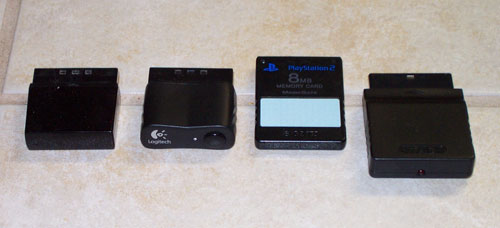
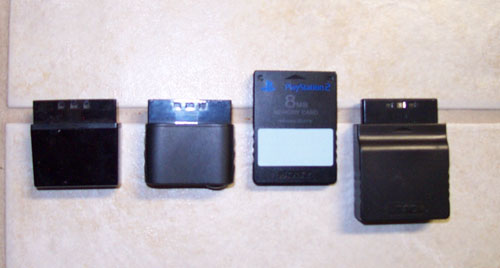
The receiver is a bit on the largish side. I've posted front-angle and top-down images so that you can get an impression of how large it is, compared to (from left to right) the official Sony PS2 Infrared DVD Remote receiver, a PS2 Logitech Cordless Action Controller receiver, a PS2 memory card, and the Freedom V Wireless receiver. The receiver is also a *very* firm fit in the PS2, moreso coming out of it, so be sure to hold your PS2 with one free hand while trying to remove the receiver, lest you yank it right off the platform. 
Another really nifty touch is the LED inside the guitar. You won't really see this until you start playing (since the LED will only power on when the guitar is sync'ed with the receiver and the game is running). It's kinda nifty, and I think might lend the Freedom V Wireless to fan modifications a little bit (adding a window, changing the LED, for example). There's plenty of juice to spare on the batteries, as the rated playtime is 1000 hours on a set of 4-AA batteries. I'd expect that people probably wouldn't even play with the controller that much in a year's time. Furthermore, the controller will suspend itself if it can't contact the receiver, so that helps to save power if you leave it turned on by accident. Very nifty. So, now that I've glossed over some of the controller's features, how does it actually play? Pretty well. It's a little bit different than how I normally handle the SG controller. For starters, the slick surface of the V meant that my right arm kept pushing it up a bit as I was playing, so I had to tighten up the strap in order to minimize the movement. Once I did that though, it worked pretty well. The same smoothness also applies to the pick. This didn't really cause me any problems, but I was wishing that the pick had been textured somewhat so that it'd be easier to keep traction on when having to use it furiously. It's hard to comment on the feel of the "build" of the controller, as I've actually handled two. I've heard some complaints for early adopters about the quality of their controllers. The first one I got was great. Except it would randomly lose power. That's pretty much a deal-breaker for anyone. I contacted TAC and they swapped out controllers for me, and the new one works fine, but the whammy bar requires almost the full range of motion to activate. On the previous controller, the whammy bar was *very* sensitive, and I loved it for that - the whammy bar on my SG controller is really loose-feeling and pretty much matches what I have now on the new Freedom V Wireless, so that's a bit disappointing. The neck buttons are pretty sensitive for me. I've read some people complaining about them, but they're the same shape and size as the ones on my SG controller, so I'm not sure where the complaining is coming from, unless people are wanting some improvement. I could see where that would be merited. It would be nice if the surfaces of the buttons were more convex so that a player could easily slide up and down the neck when trying to do some fast-moving patterns, such as what's visible in a lot of the solo portions of harder songs. I would also have liked to have seen a thinner neck on the controller, or something with a nicer contour for the left hand. I sometimes get wrist pains after extended playing sessions, and I'm sure I'm not the only one. This isn't something that's a fault of the Freedom V Wireless, of course - it's pandemic to all guitar controllers, and many guitars themselves. I look forward to seeing some creative solutions for this problem. Speaking of "creative", I was also pleasantly surprised to see that in designing the Freedom V Wireless, TAC has given thought to the southpaws. You can easily reorient the strap and turn the guitar around if you're of the left-handed persuasion (since Guitar Hero apparently supports this in software, you should be good to go). The whammy bar might get in the way if you're a lefty, but I think most southpaws would probably agree that it's nice to have even this level of support in a guitar, whereas some southpaws have just had to adapt to normal guitars for regular play. TAC also relocated the Start and Select buttons. This is pretty visible just looking at the comparison shots of the two controllers. If you're very used to the SG controller, you might find the new button positioning a bit hard to work with, but it's intended to be more convenient to activate Star Power with now, in that you can just push your right hand down and hit the Select button with the ball of your thumb. The Start button is recessed, so it's more difficult to accidentally pause the game. That's a very nice feature. The balance of it is really good. I mean, really, really good. It feels very comfortable and it's fun to hold and play with. Interesting story - I only recently found out that you could activate Star Power by wailing with the guitar. The entire time I had Guitar Hero, I never accidentally triggered it on my guitar - I always used the Select button to do it. With this guitar, I was using Star Power by accident, simply by virtue of the fact that I was enjoying swinging the guitar around like a freak with an air guitar! It was really great. The radio never skipped a beat, and functioned flawlessly. My TV is not terribly huge, but I was able to play from over 40 feet away, going down the hallway leading to my living room, and it worked perfectly fine. I never experienced any sort of latency that commonly upsets owners of wireless dance pads and similar peripherals. Granted, Guitar Hero is not the most timing-sensitive of games so there's a lot of room for error, but...well...we'll get back to this particular topic later. :) I'd recently heard some rumors about people having trouble using the Freedom V Wireless with the new Guitar Hero 2 demo that came in the November '06 edition of Official PlayStation Magazine, so naturally, I went out to acquire the demo and give it a shot myself, and it worked perfectly fine, even with GH2's controller detection system. It turns out that my controller was one of the first of a new batch made by The Ant Commandos which has the appropriate buttons soldered down so that Guitar Hero 2 will recognize it as a guitar controller. TAC tells me that all controllers sold in October 2006 and onward will perform this way. For those early adopters, however, you're not completely out of luck - TAC will be offering an adapter in mid-November for $6.99 shipped that will allow you to use your existing TAC controller in Guitar Hero 2. It's not free, sure, but it's also a really good deal. For some time after the release of Guitar Hero, there was speculation as to whether or not Konami would modify Guitar Freaks to use the Guitar Hero controller, since it's in wider circulation than the Guitar Freaks controllers ever got to be in the seven years of home versions GF has seen. Interestingly enough, Konami actually *did* modify GuitarFreaks Drummania Masterpiece Silver to allow for user button customization, meaning that it is indeed possible to use a Guitar Hero controller on Guitar Freaks now (though this is completely unsupported by anyone, most especially The Ant Commandos). There are a few catches, of course. For starters, the accelerometer in the guitar is mapped to either L3 or R3, and Guitar Freaks only allows L3 and R3 to be assigned as "Pick", so you'll have to get your wailing bonus using a button (though it is conceivable that a modified game save file could make this work). Secondly, and much more significantly, on official SG controllers (and TAC controllers from here on out), since the right and left D-pad sensors are permanently on, this makes the songwheel fly around. You can think of it as permanent Random if you want, though it's not that hard to time the wheel for a particular song. And this is where early adopters have an advantage - if you want to use your older Freedom V Wireless as a GF controller, just don't use the Guitar Hero adapter, and you don't have to worry about this problem at all! Now, is the Freedom V Wireless appropriate to play GuitarFreaks? It worked pretty well for me. I'm no pro at GF, so I was just playing around with it, but I was able to pass some low 30s songs with the controller and it seemed to work okay. More than anything, it's hard to transition between the game types. I would want to hold down all three buttons to hit one note. More professional GF players might disagree with me on the usability (then again they might be purist enough to refuse to play on anything other than a GF controller itself), but it's fun to experiment with, especially if you're not sure if you'd like to get into GuitarFreaks or not. So, where do we stand at the end of the day? The Freedom V Wireless is pretty good all-around. It has some minor nuances, and potentially some manufacturing problems, but if you're interested in one, I think it's worth taking the leap for it. If you're not satisfied with it, just return it until things are right. The Freedom V Wireless has some great potential, and several months lead-time on the market compared to the SG wireless coming from RedOctane. And really, the SG wireless just looks like a carbon copy of the existing controller with a slightly different neck design. Nothing special. The Freedom V Wireless *looks* special, and it's fun to hold and use, and I certainly would have no regrets recommending it to a friend. The Freedom V Wireless retails for $49.99 plus shipping, and can be purchased through The Ant Commandos' official website at TheGuitarMania.com. | ||||||||||||||||||||||||||||||||||||||||||||||||||||||||||||||||||||||||||||||||||||||||||||||||||||||||||||||||||